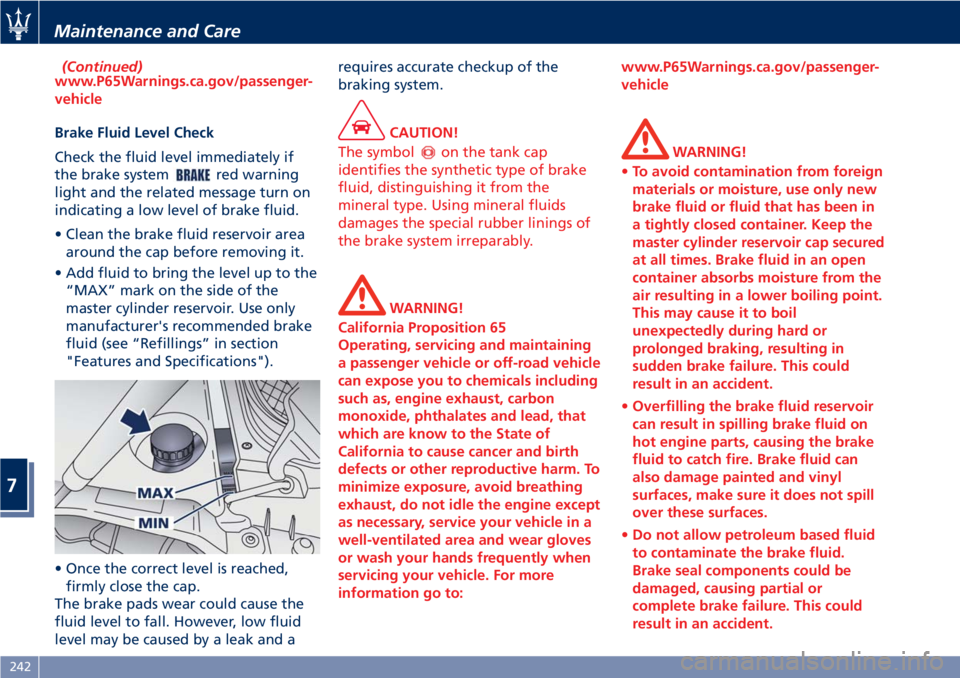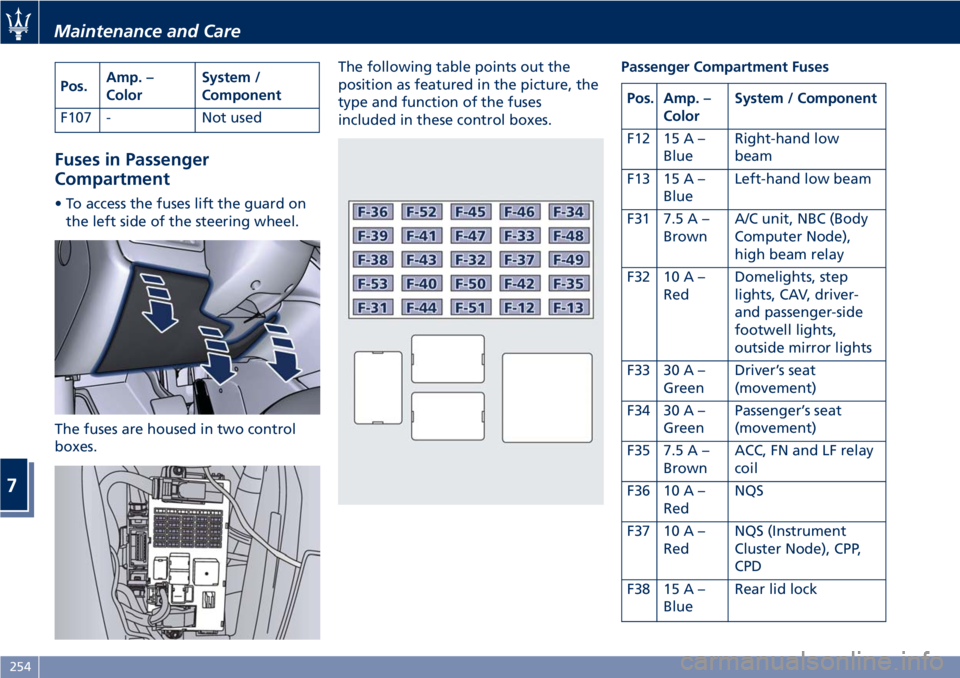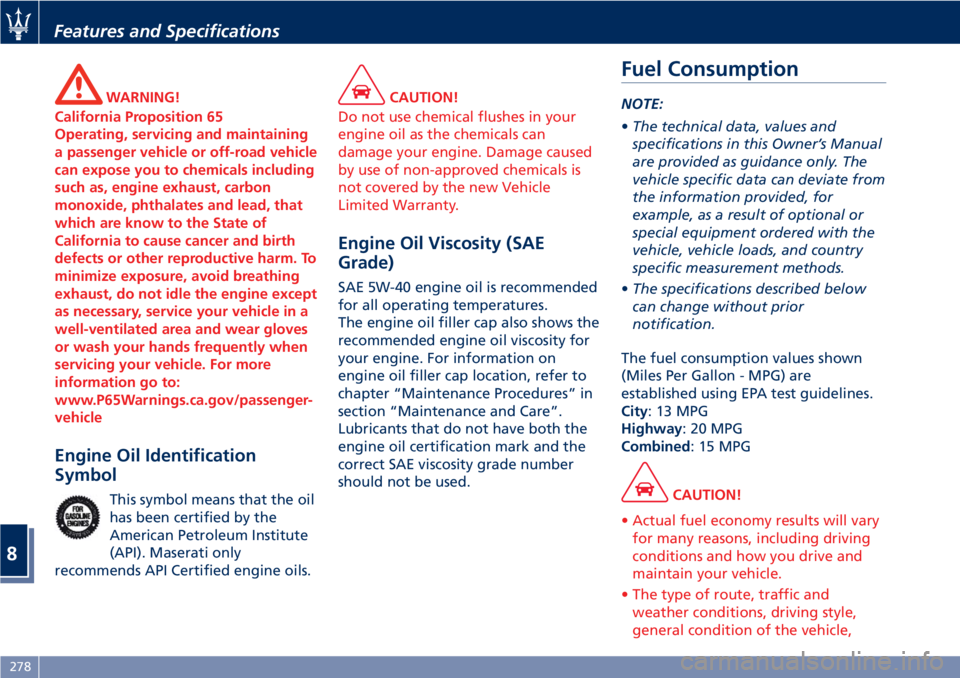2020 MASERATI GRANTURISMO CONVERTIBLE oil type
[x] Cancel search: oil typePage 17 of 296

WARNING!
California Proposition 65
Operating, servicing and maintaining
a passenger vehicle or off-road vehicle
can expose you to chemicals including
such as, engine exhaust, carbon
monoxide, phthalates and lead, that
which are know to the State of
California to cause cancer and birth
defects or other reproductive harm. To
minimize exposure, avoid breathing
exhaust, do not idle the engine except
as necessary, service your vehicle in a
well-ventilated area and wear gloves
or wash your hands frequently when
servicing your vehicle. For more
information go to:
www.P65Warnings.ca.gov/passenger-
vehicle
Warning Symbols
Catalytic converter
Do not park the vehicle
over flammable materials.
Refer to chapter “Pollution
Control Devices” in section
"Driving".
Engine - Engine Oil Filler
Cap
Engine oil. We recommend
you use oil with the
characteristics indicated in
chapter “Refillings” in
section “Features and
Specifications”.
Hydraulic steering
reservoir
Power steering fluid. Do
not exceed max. level. We
recommend you use liquid
with the characteristics
indicated in chapter
“Refillings” in section
“Features and
Specifications”.
Brake fluid reservoir
Brake fluid type DOT 4. Do
not exceed max. level. We
recommend you use fluid
with the characteristics
indicated in chapter
“Refillings” in section
“Features and
Specifications”.
Radiator coolant expansion
reservoir
Use antifreeze liquid for
radiators with the
characteristics indicated in
chapter “Refillings” in
section “Features and
Specifications”.
Windshield washer fluid
reservoir
Windshield washer. We
recommend you use liquid
with the characteristics
indicated in chapter
“Refillings” in section
“Features and
Specifications”.
Introduction
1
13
Page 33 of 296

ENVIRONMENTAL!
Batteries contain dangerous materials
that could harm the environment.
Please dispose of them according to
local regulations or at an Authorized
Maserati Dealer.
WARNING!
California Proposition 65
Operating, servicing and maintaining
a passenger vehicle or off-road vehicle
can expose you to chemicals including
such as, engine exhaust, carbon
monoxide, phthalates and lead, that
which are know to the State of
California to cause cancer and birth
defects or other reproductive harm. To
minimize exposure, avoid breathing
exhaust, do not idle the engine exceptas necessary, service your vehicle in a
well-ventilated area and wear gloves
or wash your hands frequently when
servicing your vehicle. For more
information go to:
www.P65Warnings.ca.gov/passenger-
vehicle
NOTE:
Avoid touching the new battery with
your fingers. Skin oils may cause
battery deterioration. If you touch a
battery, clean with alcohol.
• Fit a new battery of the same type,
observing the indicated polarity:
match the "+" sign on the battery to
the "+" sign on the inside of the
battery holder.
• Fit the battery holder into the radio
control case and secure it by
tightening the retaining screw.
Radio Frequency Transmitter -
General Information
Some countries do not require a
specific domestic homologation in the
event that the vehicle has already
obtained other European
homologations.The homologation number (EEC
regulations) of the radio control
device is indicated in the picture.
The current device feature is subject to
following conditions:
• This device may not cause harmful
interference.
• This device must accept any
interference received, including
interference that may cause
undesired operation.
If your transmitter device fails to
operate from a normal distance, check
for these two conditions:
• A weak battery in the transmitter
device. The expected life of the
battery in normal use is a minimum
of three years.
• Closeness to a radio transmitter such
as a radio station tower, airport
Before Starting
2
29
Page 187 of 296

Use of the Engine
Breaking-In
Today's most modern production
methods are designed to provide
extremely precise construction and
assembly of components. However,
moving parts do undergo a settling
process, basically in the first hours of
vehicle operation.
Do not drive keeping at a constant
high speed rate for a prolonged time.
While cruising, brief full-throttle
acceleration within the limits of local
traffic laws contributes to a good
break-in. Wide-open throttle
acceleration in low gear can be
detrimental and should be avoided.
The engine oil installed in the engine
at the factory is a high-quality energy
conserving type lubricant. Oil changes
should be consistent with anticipated
climate conditions under which vehicle
operations will occur. For the
recommended viscosity and quality
grades, see “Refillings” in section
“Features and Specifications”.
A new engine may consume some oil
during its first few thousand
kilometers of operation. This should
be considered as a normal part of thebreak-in and not interpreted as an
indication of malfunction.
Avoid exceeding 5000 rpm for the first
620 trip mi (1000 km).
After starting the vehicle, do not
exceed 4000 rpm until the engine has
warmed up sufficiently (coolant
temperature: 149-158°F/65-70°C).
While Driving
Never travel with the tachometer
indicator approaching the peak rpm,
not even downhill. When the
tachometer indicator is approaching
the peak rpm (red colored zone), take
precautions to avoid exceeding that
limit.
Ensure proper operation of different
devices checking their respective
control telltales.
CAUTION!
• Under normal conditions, all red
warning lights on the instrument
cluster display should be off. When
they come on, they indicate a
malfunction. Refer to “Instrument
Cluster” in section “Dashboard
Instruments and Controls”.
• Continuing to drive when a red
warning light is on could cause
serious damage to the vehicle and
affect its performance.
WARNING!
Do not travel downhill with the
engine off, as the servo brake will no
longer function due to the vacuum
decrease and thus after a few braking
attempts, the system becomes totally
inefficient. The power steering will
also lose its efficiency under these
conditions.
Onboard Diagnostic System
Your vehicle is equipped with a
sophisticated onboard diagnostic
system. This system monitors the
performance of the emissions, engine,
Driving
5
183
Page 246 of 296

(Continued)
www.P65Warnings.ca.gov/passenger-
vehicle
Brake Fluid Level Check
Check the fluid level immediately if
the brake system
red warning
light and the related message turn on
indicating a low level of brake fluid.
• Clean the brake fluid reservoir area
around the cap before removing it.
• Add fluid to bring the level up to the
“MAX” mark on the side of the
master cylinder reservoir. Use only
manufacturer's recommended brake
fluid (see “Refillings” in section
"Features and Specifications").
• Once the correct level is reached,
firmly close the cap.
The brake pads wear could cause the
fluid level to fall. However, low fluid
level may be caused by a leak and arequires accurate checkup of the
braking system.
CAUTION!
The symbol
on the tank cap
identifies the synthetic type of brake
fluid, distinguishing it from the
mineral type. Using mineral fluids
damages the special rubber linings of
the brake system irreparably.
WARNING!
California Proposition 65
Operating, servicing and maintaining
a passenger vehicle or off-road vehicle
can expose you to chemicals including
such as, engine exhaust, carbon
monoxide, phthalates and lead, that
which are know to the State of
California to cause cancer and birth
defects or other reproductive harm. To
minimize exposure, avoid breathing
exhaust, do not idle the engine except
as necessary, service your vehicle in a
well-ventilated area and wear gloves
or wash your hands frequently when
servicing your vehicle. For more
information go to:www.P65Warnings.ca.gov/passenger-
vehicle
WARNING!
•To avoid contamination from foreign
materials or moisture, use only new
brake fluid or fluid that has been in
a tightly closed container. Keep the
master cylinder reservoir cap secured
at all times. Brake fluid in an open
container absorbs moisture from the
air resulting in a lower boiling point.
This may cause it to boil
unexpectedly during hard or
prolonged braking, resulting in
sudden brake failure. This could
result in an accident.
•Overfilling the brake fluid reservoir
can result in spilling brake fluid on
hot engine parts, causing the brake
fluid to catch fire. Brake fluid can
also damage painted and vinyl
surfaces, make sure it does not spill
over these surfaces.
•Do not allow petroleum based fluid
to contaminate the brake fluid.
Brake seal components could be
damaged, causing partial or
complete brake failure. This could
result in an accident.
Maintenance and Care
7
242
Page 258 of 296

Pos.Amp. –
ColorSystem /
Component
F107 - Not used
Fuses in Passenger
Compartment
• To access the fuses lift the guard on
the left side of the steering wheel.
The fuses are housed in two control
boxes.The following table points out the
position as featured in the picture, the
type and function of the fuses
included in these control boxes.Passenger Compartment Fuses
Pos. Amp. –
ColorSystem / Component
F12 15 A –
BlueRight-hand low
beam
F13 15 A –
BlueLeft-hand low beam
F31 7.5 A –
BrownA/C unit, NBC (Body
Computer Node),
high beam relay
F32 10 A –
RedDomelights, step
lights, CAV, driver-
and passenger-side
footwell lights,
outside mirror lights
F33 30 A –
GreenDriver’s seat
(movement)
F34 30 A –
GreenPassenger’s seat
(movement)
F35 7.5 A –
BrownACC, FN and LF relay
coil
F36 10 A –
RedNQS
F37 10 A –
RedNQS (Instrument
Cluster Node), CPP,
CPD
F38 15 A –
BlueRear lid lock
Maintenance and Care
7
254
Page 281 of 296

Parts to be refilled Quantity Product specifications
Engine cooling circuit 3.43 US gal/13 liters Mixture of water and coolant, proportionally 50/50%.
Coolant: protective, antifreeze action and ethylene
glycol-based with organic inhibitors compatible with
regulations:
• ASTM D 3306, ASTM D 2570
• ASTM D 4340, ASTM D 2809
• SAE J 1034
• CUNA NC 956/16.
Recommended fluid: SHELL GlycoShell or GlycoShell Long
Life.
Hydraulic power steering 0.26 US gal/1,0 liters +/-4% Oil: ATF TypeA-MB236.2.
Recommended oil: SHELL Donax TM.
Automatic transmission 2.63 US gal/10,03 liters Recommended oil: SHELL M1375.4 DEXTRON III.
Differential 2.4 lb/1,1 kg Recomended oil: SHELL Spirax S 75W140.
Braking system 0.29 US gal/1,1 liters +/-4% Synthetic fluid: FMVSS 116-DOT 4, ISO 4925 Class 4, ENSAYOS
INTA-UNE 26-109-88, SAE J1703, SAE J1704, CUNA NC 956-01.
Recommended fluid: PETRONAS Tutela TOP 5 FF.
CAUTION!
For each oil refilling and/or replacement, please contact anAuthorized Maserati Dealer.
Air conditioning system 1.32 lb +/-0.045 lb
600 g +/-20 gCoolant: R134a.
Air Conditioning
compressor0.053 US gal +/- 0.0026 US gal
200 ml +/- 10 mOil Type: PS-D1.
Features and Specifications
8
277
Page 282 of 296

WARNING!
California Proposition 65
Operating, servicing and maintaining
a passenger vehicle or off-road vehicle
can expose you to chemicals including
such as, engine exhaust, carbon
monoxide, phthalates and lead, that
which are know to the State of
California to cause cancer and birth
defects or other reproductive harm. To
minimize exposure, avoid breathing
exhaust, do not idle the engine except
as necessary, service your vehicle in a
well-ventilated area and wear gloves
or wash your hands frequently when
servicing your vehicle. For more
information go to:
www.P65Warnings.ca.gov/passenger-
vehicle
Engine Oil Identification
Symbol
This symbol means that the oil
has been certified by the
American Petroleum Institute
(API). Maserati only
recommends API Certified engine oils.
CAUTION!
Do not use chemical flushes in your
engine oil as the chemicals can
damage your engine. Damage caused
by use of non-approved chemicals is
not covered by the new Vehicle
Limited Warranty.
Engine Oil Viscosity (SAE
Grade)
SAE 5W-40 engine oil is recommended
for all operating temperatures.
The engine oil filler cap also shows the
recommended engine oil viscosity for
your engine. For information on
engine oil filler cap location, refer to
chapter “Maintenance Procedures” in
section “Maintenance and Care”.
Lubricants that do not have both the
engine oil certification mark and the
correct SAE viscosity grade number
should not be used.
Fuel Consumption
NOTE:
•The technical data, values and
specifications in this Owner’s Manual
are provided as guidance only. The
vehicle specific data can deviate from
the information provided, for
example, as a result of optional or
special equipment ordered with the
vehicle, vehicle loads, and country
specific measurement methods.
•The specifications described below
can change without prior
notification.
The fuel consumption values shown
(Miles Per Gallon - MPG) are
established using EPA test guidelines.
City:13MPG
Highway:20MPG
Combined:15MPG
CAUTION!
• Actual fuel economy results will vary
for many reasons, including driving
conditions and how you drive and
maintain your vehicle.
• The type of route, traffic and
weather conditions, driving style,
general condition of the vehicle,
Features and Specifications
8
278